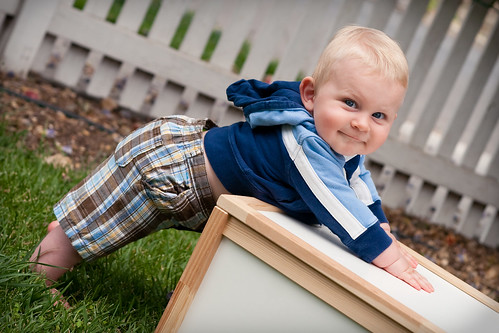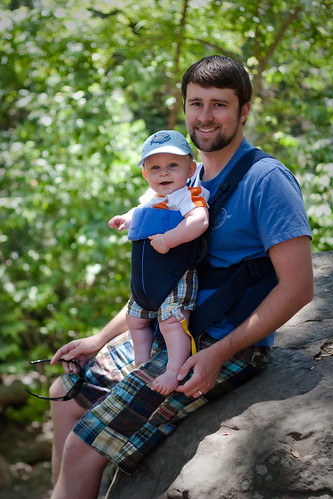Rather than just list out every helpful tip I can think of, I thought I'd try and choose one topic at a time and explore it more fully.
I wanted to start with lighting. I think one of the best things you can do for your portrait photography is to be intentional about where you take your pictures and what kind of lighting you're going to find there.
What to Avoid
There are probably creative ways to make the lighting in any situation work for you. In general, though, try to avoid shooting in direct sun, especially during the middle of the day. Direct sun will make your kids squint, and will cast really harsh shadows on their face. If you're not intentional about your lighting, most of your shots will probably end up being in full sun.
Things to Try
Shoot in the shade
Your best bet is to shoot in some form of shade. A partly cloudy day, where there are some clouds covering the sun, is the most convenient source of light for this. You can shoot anywhere that's normally in full sun (which is most places), but the clouds will soften and diffuse the light. The below photo was probably taken on a partly cloudly or overcast day. You can see the light is really even and there are no harsh shadows.

| Tip: Shade and White Balance White balance is an important part of portrait photography in general, but it's especially important when shooting in the shade. The light on a cloudy day, for example, will add a bluish cast to your photos. Use your camera's white balance settings to correct for this, or adjust the white balance in your editing software to warm up the photo. |
The other good source of diffused light is the shade of a tree. Some spots will provide full shade, but others often give you mottled light with small patches of shade and diffused light. In the below shot of me (with quite the mop growing on my head) and Logan, we're under shade from a tree and a shrub, and there are patches of light making their way in.

That's a very nice motorcycle helmet you've got there, Chris
I'm not completely sure what I think of patchy light versus perfectly-even light. I guess they're just different--patchy light may be less ideal for getting a clear and detailed capture of someone's face, but it seems to add some lightness and fun to the atmosphere of the portrait.
Pay attention to the edges of your shade
Something that can look pretty bad is having most of your image covered in shade, but large parts of it exposed to the sun. A mistake we've made a number of times is to shoot in the shadow cast by our house, but to include in the frame some of the yard or fence which is hit by full sun. This is especially bad because of the rigid outline of the house--the edge of the shadow becomes a very bold and distracting line.

Back-lit subjects
You may think that a back-lit subject is hopeless, but back-lighting can actually be used to great effect. Try back-lit photos in the early morning or late afternoon when the sun is low in the sky and the light is soft.

Isn't she beautiful!? The little guy, too :)
There a number of things which make this whole back-lighting approach work well. One is that all of the light on your subject is being reflected off of other surfaces, so it's diffused and even. Another is that you will often end up over-exposing the background, which can help remove distractions and bring the focus to your subject. Finally, it can have a pretty cool effect on your subject's hair, producing a sort of golden halo around their face.

Our friends Sarah and Wyatt. Way to model back-lighting, guys!
The key to back-lighting is to exercise some control over the exposure. The background will often be very bright compared to the front of your subject. Your camera will take the average brightness of the scene and calculate an exposure based on that, but it will probably result in under-exposing your subject. Figure out how to use the exposure bias on your camera (even point-and-shoots have this feature!) and "over-expose" the shot by a stop or two.
Professionals will apply a technique called "spot-metering", where they change the metering mode of their camera, zoom in on the subject, press the shutter release half way and use that metering for the exposure settings. Jess and I are generally a little lazier, though. We just pick an amount to over-expose by (a somewhat-educated guess based on the lighting), try it and check the image on the LCD. You can usually tweak your exposure a little after-the-fact, too, in your editing program.
An interesting point for those of us living on the coast is that back lighting also tends to be about the only way to get a good picture at the beach (when there are no clouds in the sky). Jess and I notice this a lot in professional engagement photos at the beach. The sun is behind the couple, and the sky is completely blown-out (over-exposed) in order to get a good exposure of the subject.
Conclusion
I hope that helps some; have fun shooting your family and friends!

And if you take some pictures with some intentional light choices, be sure to share them in the comments below!

nice blog ....I have a website about http://www.royalbambino.com/Chandeliers_c_64.html
ReplyDeleteWow, amazing and impressive photos within the tips for making happen these kind of photography and also what to avoid by getting know about it by your post sharing. Thanks a lot. Candid Wedding Photographers | Couple Photoshoot In Coimbatore | Destination Wedding Photographers In Coimbatore
ReplyDelete